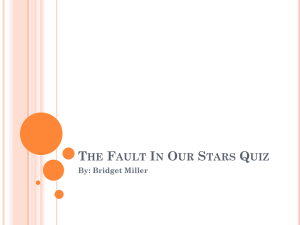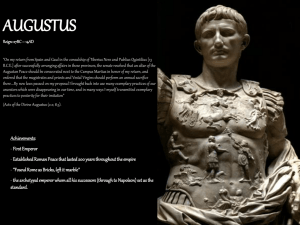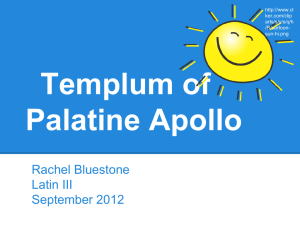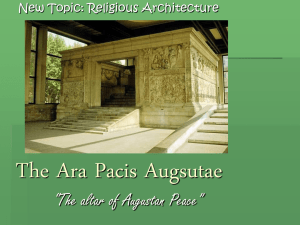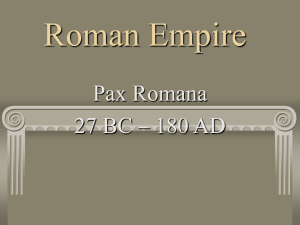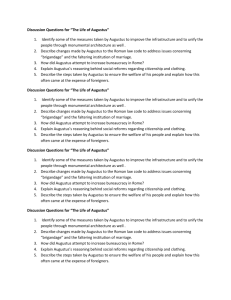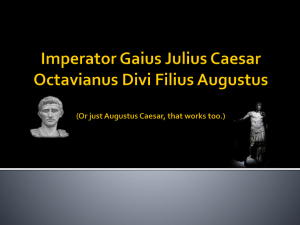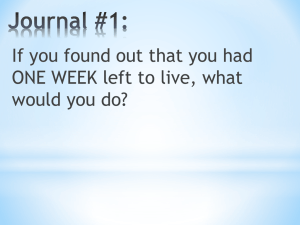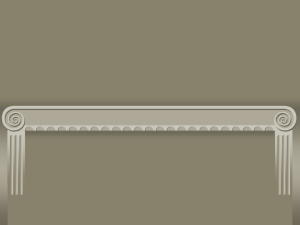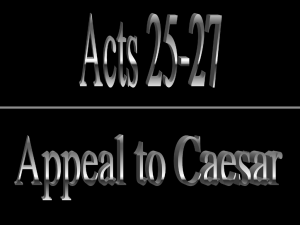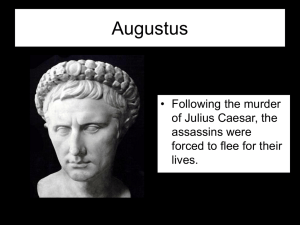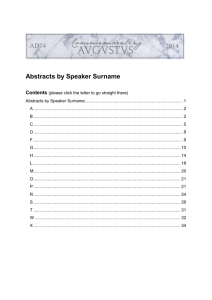ACH
advertisement
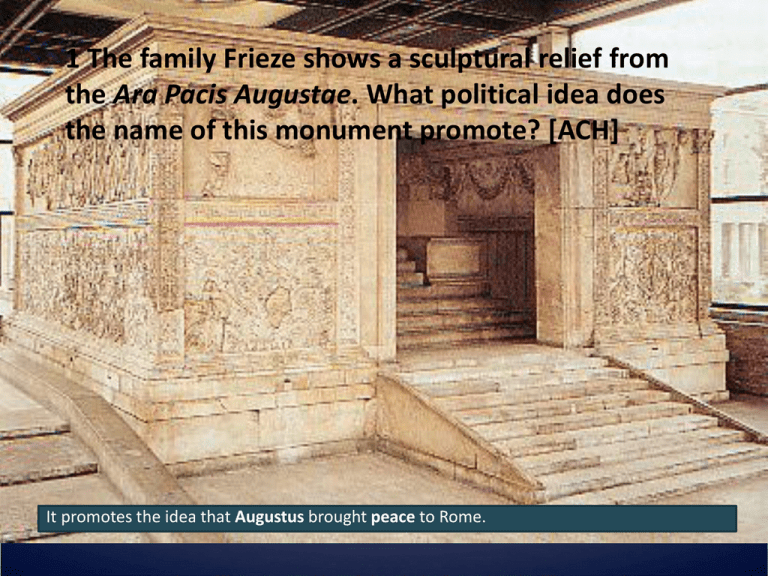
1 The family Frieze shows a sculptural relief from the Ara Pacis Augustae. What political idea does the name of this monument promote? [ACH] It promotes the idea that Augustus brought peace to Rome. (2) Explain the original function of this monument. [ACH] It was an altar used for (annual) sacrifices (to the goddess Peace). (3) The people depicted on this relief are priests and members of Augustus’ family. What exactly are they doing here? [ACH] They are taking part in the dedication ceremony of the altar. (4) What is the mood of this relief? You must identify TWO aspects of this mood. [ACH] • • • Calm • Solemn • United in purpose. • Dignified Devout Pious/Peaceful (5) (i) Who is the child depicted on the left of the relief shown in the family Frieze? (ii) Explain TWO ways in which the children shown on this monument are of special relevance to Augustus’ rule. [MER] (i) (ii) One of Augustus’ grandsons or adopted sons or Gaius. Relevance of children: • they represent the dynastic hopes of Augustus for the future/the importance he placed on finding a successor • they symbolise Augustus’ hopes for an increased birth-rate as a result of his legislative reforms • they are a sign of the importance of family life in the stable, prosperous Rome re-established by Augustus. (Other points are possible.) (6) Discuss the sculptors’ treatment of drapery on this relief. You must make THREE detailed points and provide examples from family Frieze to illustrate your answer. [MER] Treatment of drapery: • The variation in folds indicates the weight of fabric: eg the thinner material of Julia’s dress is shown by the finer vertical folds at the bottom • Drapery outlines the shape of the body: eg Julia’s cloak stretches over her arm to reveal its shape. • Drapery moves with the body: eg as Agrippa lifts his left arm, his sleeve drapes down naturally. • The variety in thick and narrow folds replicates the natural fall of drapery: eg Agrippa’s cloak is draped in sweeping curves as it goes over the shoulder. • Differing styles of dress are shown: eg Gaius, as a child, wears a tunic. • Drapery is worn to reflect the solemn occasion: eg Agrippa covers his head with cloak as a sign of piety. (Other points are possible.) (7) Evaluate the sculptors’ success in depicting a real procession on this relief. In your answer you must discuss in detail the movement and direction of the figures, their poses, their height, and the depth of the relief. Give specific examples to illustrate your answer. (i) Movement and direction: (ii) Poses: (iii) Height of the figures: (iv) Depth of the relief: [EXC] (i) Movement and direction: Indication of movement in a (solemn) procession. The participants appear to be moving in the same direction, as their bodies are mainly turned towards the left. (ii) Poses: Agrippa’s feet point in different directions and this reflects the fact that he is moving slowly or even standing still at this stage as one might do in a real procession. OR The child looks up (towards Julia) as if he is trying to attract her attention. OR There are a variety of poses – Agrippa’s body is in a ¾ pose and his face is in profile, whereas Julia’s body is almost full frontal and her face in ¾. (iii) Height of the figures: Variation in the height of the figures adds to the naturalism of the scene. Figures in the foreground, such as the priests, stand taller than those in the background. OR Agrippa is taller than everyone else, OR the child Gaius reaches only to the elbow of his mother. (iv) Depth of relief: The sculptors have shown depth by carving the figures in the foreground in deep relief: eg Agrippa etc and the figures in the background in shallow relief, eg the priests between Julia and Agrippa. (Other examples are possible in all areas.) (8) Explain THREE political messages delivered by this structure. How has each message been delivered? 1) Augustus is the bringer of peace -The title of the Ara Pacis confirms this -On the eastern side Roma is depicted in a peaceful pose 2) Augustus brings a new age of prosperity and fertility -Tellus frieze (earth goddess) with two children on her lap, and fruit and cereal -On north and both side many children are depicted in the procession including Augustus’ own grand children represent the fertility of Rome and the growth of the imperial family 3) Augustus is one of the greatest political leaders -He is depicted on the Altar with Aeneas and Romulus, Rome’s other great leaders/founders -The reliefs on the north and south show nobility and patricians gathered to honour Augustus 4) While peace has been achieved, Rome is still ready to support it with arms. -Mars is present and fully armed, -Roma is present fully armed 5) The divine origin of Rome and the Imperial Family -Stories of Aeneas, Mars, Romulus & Remus. -Divine lineage for Aeneas to Augustus
